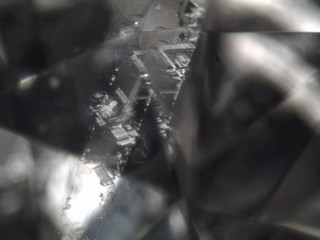A Twinning Line is a specific type of diamond inclusion that appears as a line or ribbon of small marks, which can include pinpoints, feathers, clouds, and crystals. These lines are typically visible under magnification and are a result of the natural growth process of diamonds within the Earth’s crust. They are a characteristic feature of diamonds that have undergone the complex geological conditions that contribute to their formation.
Formation of Twinning Lines
Twinning lines are created when two rough diamonds have grown together during the process of diamond formation, which takes place deep within the Earth under extreme heat and pressure. This interaction causes a part of the diamond’s crystal structure to form in alignment with the other diamond, resulting in the characteristic lines or ribbons of inclusions.
In most cases, the twinning line represents the point where two diamond crystals have joined or interacted during the diamond’s formation. Over time, as the diamonds are subjected to various geological pressures and environmental conditions, these areas of growth can lead to the inclusion of tiny pinpoints, feathers, or other microscopic crystals, creating a visible line within the diamond’s structure.
Characteristics of Twinning Lines
Appearance:
Twinning lines appear as linear inclusions that may be faint or more prominent depending on the diamond. The line often looks like a ribbon or strip, and it may be composed of multiple inclusions, such as pinpoints, tiny feathers, or clouds, which are all clustered together in the line.
These lines can vary in appearance, some being thin and subtle, while others may be more bold and visible under magnification.
Location:
Twinning lines are typically found within the interior of the diamond, often extending across the girdle, pavilion, or crown. However, the location can vary, and they may be visible on any facet of the diamond, depending on how the rough diamond has formed.
The inclusions formed by twinning lines may not always be visible to the naked eye, but they are often detectable under 10x magnification, which is commonly used by gemologists to inspect diamonds during grading.
Nature of Inclusions:
The inclusions that form along twinning lines are often a mix of pinpoints (tiny, round inclusions), feathers (thin, hair-like cracks or fractures), clouds (groupings of pinpoints or other inclusions that create a hazy appearance), and crystals (other mineral crystals that may be trapped inside the diamond).
These inclusions are usually microscopic, but in some cases, they can affect the overall clarity of the diamond, depending on their size and concentration.
Gemological Significance of Twinning Lines
Identification:
Twinning lines serve as an important feature for identifying diamonds. They are a unique inclusion type that is generally found in natural diamonds, making them a useful tool for gemologists and diamond appraisers when distinguishing between natural and synthetic diamonds.
When present, twinning lines are often recorded in the diamond’s grading report to help trace the diamond’s origins and confirm its authenticity.
Clarity Grade Impact:
The presence of twinning lines can affect the clarity grade of a diamond. Depending on the visibility and size of the inclusions within the twinning line, they may cause the diamond to be graded lower for clarity. However, if the twinning line is internal and does not interfere with the diamond’s surface or overall aesthetic appeal, the impact on the clarity grade may be minimal.
In some cases, diamonds with visible twinning lines might be priced lower than those with fewer or no inclusions, though this also depends on other factors such as the diamond’s size, cut, and colour.
Value Consideration:
Twinning lines do not necessarily have a significant effect on a diamond’s overall market value, particularly if they are small and not easily visible to the naked eye. However, in diamonds with heavier twinning inclusions, these markings may slightly decrease the value depending on their visibility and impact on the diamond’s overall appearance and clarity.
For many diamond buyers, the presence of twinning lines might not be a major concern, especially when purchasing diamonds with high colour and cut quality. However, collectors or those seeking the most flawless diamonds may prefer stones that are free from such inclusions.
Twinning Lines and Diamond Quality
Impact on Aesthetics:
Twinning lines are generally considered natural features of a diamond and are not seen as negative traits by many buyers. While they may cause slight cloudiness or haziness, particularly when accompanied by other inclusions, they do not detract from the overall beauty of the diamond as long as they are not too prominent.
The quality of the diamond’s cut can sometimes mitigate the effects of twinning lines, as a well-cut diamond will often have more sparkle and brilliance, making inclusions like twinning lines less noticeable.
The “Twinning” Phenomenon:
The term “twinning” refers to a specific crystallographic phenomenon where the crystal lattice of two diamond crystals becomes intertwined during their formation. This causes the diamonds to grow in mirror-image symmetry, leading to the creation of the twinning line. This natural occurrence can make diamonds with twinning lines unique and interesting, offering a fascinating glimpse into the diamond’s formation process.
Twinning lines are an intriguing and distinctive type of diamond inclusion formed when two rough diamonds grow together during the natural crystallisation process. These lines appear as ribbons or stripes of small inclusions, such as pinpoints, feathers, clouds, and crystals. While they can affect the diamond’s clarity grade, they are typically a natural characteristic and are often used by gemologists to authenticate diamonds. The presence of twinning lines can slightly decrease a diamond’s value, but they do not necessarily detract from the diamond’s overall beauty or brilliance, especially if they are small and not easily visible to the naked eye.
